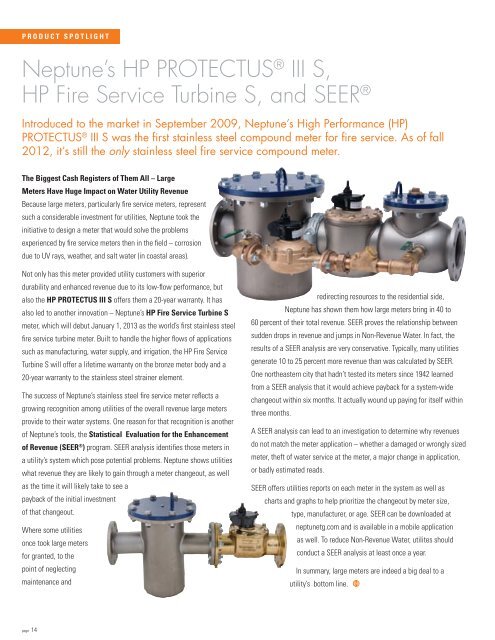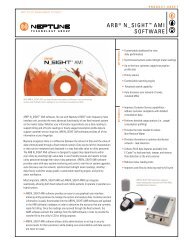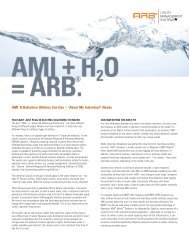Neptune NOW - Neptune Technology Group
Neptune NOW - Neptune Technology Group
Neptune NOW - Neptune Technology Group
Create successful ePaper yourself
Turn your PDF publications into a flip-book with our unique Google optimized e-Paper software.
PRODUCT SPOTLIGHT<strong>Neptune</strong>’s HP PROTECTUS ® III S,HP Fire Service Turbine S, and SEER ®Introduced to the market in September 2009, <strong>Neptune</strong>’s High Performance (HP)PROTECTUS ® III S was the first stainless steel compound meter for fire service. As of fall2012, it’s still the only stainless steel fire service compound meter.The Biggest Cash Registers of Them All – LargeMeters Have Huge Impact on Water Utility RevenueBecause large meters, particularly fire service meters, representsuch a considerable investment for utilities, <strong>Neptune</strong> took theinitiative to design a meter that would solve the problemsexperienced by fire service meters then in the field – corrosiondue to UV rays, weather, and salt water (in coastal areas).Not only has this meter provided utility customers with superiordurability and enhanced revenue due to its low-flow performance, butalso the HP PROTECTUS III S offers them a 20-year warranty. It hasalso led to another innovation – <strong>Neptune</strong>’s HP Fire Service Turbine Smeter, which will debut January 1, 2013 as the world’s first stainless steelfire service turbine meter. Built to handle the higher flows of applicationssuch as manufacturing, water supply, and irrigation, the HP Fire ServiceTurbine S will offer a lifetime warranty on the bronze meter body and a20-year warranty to the stainless steel strainer element.The success of <strong>Neptune</strong>’s stainless steel fire service meter reflects agrowing recognition among utilities of the overall revenue large metersprovide to their water systems. One reason for that recognition is anotherof <strong>Neptune</strong>’s tools, the Statistical Evaluation for the Enhancementof Revenue (SEER ® ) program. SEER analysis identifies those meters ina utility’s system which pose potential problems. <strong>Neptune</strong> shows utilitieswhat revenue they are likely to gain through a meter changeout, as wellas the time it will likely take to see apayback of the initial investmentof that changeout.Where some utilitiesonce took large metersfor granted, to thepoint of neglectingmaintenance andredirecting resources to the residential side,<strong>Neptune</strong> has shown them how large meters bring in 40 to60 percent of their total revenue. SEER proves the relationship betweensudden drops in revenue and jumps in Non-Revenue Water. In fact, theresults of a SEER analysis are very conservative. Typically, many utilitiesgenerate 10 to 25 percent more revenue than was calculated by SEER.One northeastern city that hadn’t tested its meters since 1942 learnedfrom a SEER analysis that it would achieve payback for a system-widechangeout within six months. It actually wound up paying for itself withinthree months.A SEER analysis can lead to an investigation to determine why revenuesdo not match the meter application – whether a damaged or wrongly sizedmeter, theft of water service at the meter, a major change in application,or badly estimated reads.SEER offers utilities reports on each meter in the system as well ascharts and graphs to help prioritize the changeout by meter size,type, manufacturer, or age. SEER can be downloaded atneptunetg.com and is available in a mobile applicationas well. To reduce Non-Revenue Water, utilites shouldconduct a SEER analysis at least once a year.In summary, large meters are indeed a big deal to autility’s bottom line.page 14




